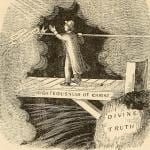Researchers have attempted to quantify the sinfulness of the various states in the union. Yes, this is absurd, as if one could measure the depravity of the human heart. But the methodology, the findings, and the rankings are interesting nonetheless.
The researchers measured “Anger & Hatred” by looking at the violent crime rate, bullying statistics, child abuse cases, and “Share of Internet Comments that are Hostile” (!), among other factors.
“Jealousy” was measured by the number of thefts per capita, the frequency of identity theft, and incidents of fraud.
“Excesses & Vices” looked at the obesity rate, number of smokers, amount of alcohol drinking, amount of drug abuse, and even the amount of coffee drinking! (How is that a vice? Do I detect a Mormon influence?)
“Greed“: number of casinos per capita; share of gambling disorders; number of people convicted of embezzlement; rate of charitable giving.
“Lust“: use of online pornography; teen birth rate; number of arrests for prostitution.
“Vanity“: beauty salons per capita; plastic surgeries; money spent on personal care products.
“Laziness“: exercise rate; hours spent working; volunteer rate; hours watching TV; youth who are neither going to school nor working.
Here is the ranking, from Wallethub [go to the link to see how each state scored on each of the “sins”]:
1 Nevada
2 Florida
3 California
4 Texas
5 Tennessee
6 Louisiana
7 Georgia
8 Illinois
9 Michigan
10 Arizona
11 New Mexico
12 Oklahoma
13 Pennsylvania
14 Ohio
15 Alabama
16 Missouri
17 New Jersey
18 Arkansas
19 South Carolina
20 Washington
21 Virginia
22 Maryland
23 Delaware
24 New York
25 Mississippi
26 Colorado
27 North Carolina
28 Kentucky
29 West Virginia
30 Alaska
31 Indiana
32 Oregon
33 Massachusetts
34 Montana
35 Kansas
36 Hawaii
37 Rhode Island
38 Connecticut
39 Minnesota
40 Wisconsin
41 South Dakota
42 New Hampshire
43 Utah
44 Wyoming
45 Iowa
46 Idaho
47 Nebraska
48 North Dakota
49 Maine
50 Vermont
Numbers 1-3, no surprises. But who knew that the great state of Texas was so wicked?
What does it mean that so many “Bible belt” states rank so high on the iniquity scale? It shouldn’t be too surprising to find much Christianity where there is much sin. After all, as Jesus said, “Those who are well have no need of a physician, but those who are sick. I came not to call the righteous, but sinners” (Mark 2:17).
What does it mean that so many predominantly Lutheran states rank towards the bottom of the sin scale? Can it be that those who put the most emphasis on the role of good works in salvation produce the fewest of them, and that those who minimize the role of good works in salvation produce more of them? Is this evidence that faith really does produce the fruit of virtue?
I would say that we should NOT draw too many theological conclusions from this research. If we did, the predominantly secularist New Englanders–though perhaps upholding the moralism of their Puritan ancestors while trying to do without their faith–would appear to be the most righteous of all.
The point, though, is that this study is primarily about culture, economics, class, homogeneity, and regional histories. It deals with external crimes and vices. But it doesn’t get at what the Bible means by sin: the condition of the human heart. Our internal sinfulness can manifest itself in these external sins. But it need not.
Thus, even upright, law-abiding, skinny citizens from Vermont who do not use personal care products are still sinners.
Illustration from WalletHub, who invited websites to embed the graphic, which shows the degree of “sin” by the darkness of the color.
Featured image: CC BY-SA 3.0, https://commons.wikimedia.org/w/index.php?curid=58686













